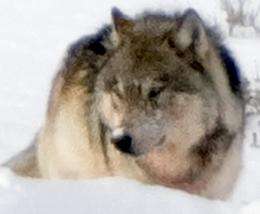Hunting affects wolves more strongly than expected, study shows

(PhysOrg.com) -- Using data from 21 North American wolf populations, two Montana State University researchers have found that the recently proposed levels of hunting for Montana and Idaho wolves are likely to have larger effects on wolf numbers than has been suggested.
Recent wolf-hunting quotas may be based on a flawed assumption that has persisted in the scientific literature for many years about how wolf populations are affected by hunting, according to a paper published by MSU ecology professors Scott Creel and Jay Rotella on Sept. 29 in PLoS One.
Research on wolf harvesting has often assumed that - human-caused mortality - like hunting and predator control operations - is mainly compensatory, meaning that hunting simply substitutes one form of death for another in the overall wolf population.
If hunting and predator control simply substitute for other causes of death, then the total death rate should not be affected, the authors explain.
Another way that human killing might not substantially affect wolf populations is that fewer wolves mean more resources for those remaining, so that the survivors thrive, the authors wrote. With either type of compensation, the net effect on a population can be negligible.
Looking at data published from 21 North American wolf populations the authors found no evidence of hunting being compensatory. Instead, increased human-caused mortality was associated with a strong increase in the overall death rate and a strong tendency for wolf populations to decline.
"If the level of harvest proposed for 2010 was implemented, the data suggest that wolf populations are likely to decline by a substantially larger margin than is currently stated by management policies," Creel said. "The underlying assumption that wolf populations can compensate for heavy levels of human harvest was not supported by the data."
The data show that annual hunting of about 22 to 25 percent is expected to be sustainable for a typical North American wolf population, Creel said.
The paper notes that in 2009 predator control practices in Montana eliminated 145 wolves, or 27.6 percent of the population. If the same number of wolves were killed through predator control and the proposed hunting quota for 2010 (186 wolves) was filled, a typical North American wolf population would decline by about half.
"Obviously, there are many factors to consider in the management of wolves, but it would be unprecedented for a species to move directly from the endangered species list to harvest of this magnitude" Creel said.
The small wolf packs that typify the Northern Rockies may be particularly affected by hunting because in a small pack, the odds are higher that any adult shot will be a breeder. Prior research has shown that packs are less likely to breed and more likely to disband when breeders die.
As Rotella summarized, "a more complete understanding of the effects of wolf harvest on wolf survival and population change ought to help managers make decisions about how to meet population goals for the species regardless of whether those goals are to reduce, maintain, or increase wolf populations."
Provided by Montana State University















